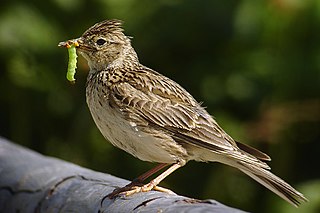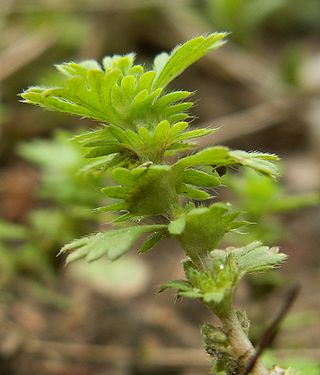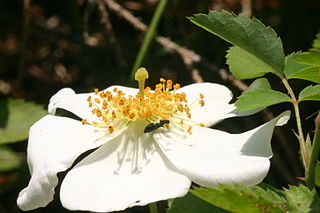
The Eurasian skylark is a passerine bird in the lark family, Alaudidae. It is a widespread species found across Europe and the Palearctic with introduced populations in New Zealand, Australia and on the Hawaiian Islands. It is a bird of open farmland and heath, known for the song of the male, which is delivered in hovering flight from heights of 50 to 100 metres. The sexes are alike. It is streaked greyish-brown above and on the breast and has a buff-white belly.

Aphanes (parsley-piert) is a genus of around 20 species in the rose family (Rosaceae), native to Europe, Asia and Australia. A 2003 study indicated that Aphanes may belong to the genus Alchemilla, commonly called lady's-mantle. They are slender, annual prostrate herbs, much-branched with deeply lobed leaves, pilose and on short petioles. The tiny green to yellow flowers without petals grow in clusters in the denticulate leaflike stipules.

Calystegia sepium is a species of flowering plant in the family Convolvulaceae. It has a subcosmopolitan distribution throughout temperate regions of the North and South hemispheres.

Portencross is a hamlet near Farland Head in North Ayrshire, Scotland. Situated about three kilometres west of Seamill and about two kilometres south of Hunterston B nuclear power station, it is noted for Portencross Castle.
The monotypic genus Yabea contains the single species Yabea microcarpa, which is known by the common names California hedge parsley and false carrot. It is similar in appearance to other species of wild carrot and relatives. It is native to western North America, including the western United States, British Columbia and Baja California. It grows in many types of habitat.
Beggar's lice is a common name for several species of plants and may refer to:
Arvensis, a Latin adjective meaning in the fields, is the specific epithet of the following:
A. arvensis may refer to:

Torilis japonica, the erect hedgeparsley, upright hedge-parsley or Japanese hedge parsley, is a herbaceous flowering plant species in the celery family Apiaceae. Japanese hedge parsley is considered both an annual and biennial plant depending on the biogeographical location. This means Japanese hedge parsley can complete its life cycle in either one or two growing seasons depending on habitat. Japanese hedge parsley is typically found in areas with disturbed soils, pastures, margins, open woodland, near waste sites, or right-of-way habitats. It can withstand a variety of habitats, thriving in partial and full shaded areas, but also withstanding habitats with full sunlight penetration. It is considered an aggressive invasive species in North America; invading a wide range of habitats due to its environmental tolerance and tendency to outcompete native vegetation. This species is considered a threat in several areas that causes problems relating to overall environmental health and stability. Aside from its environmental implications, T. japonica has potential to fight several cancers through a terpene it produces called Torilin, extracted from its fruits.
T. japonica may refer to:

Stachys arvensis is a species of flowering plant in the mint family known by the common names field woundwort and staggerweed. It is native to Europe, Western Asia, and North Africa. It is known on other continents as an introduced species and widespread weed.
British NVC community OV1 is one of the open habitat communities in the British National Vegetation Classification system. It is one of six arable weed and track-side communities of light, less-fertile acid soils.

Torilis arvensis is a species of flowering plant in the family Apiaceae known by the common names spreading hedgeparsley, tall sock-destroyer and common hedge parsley. It is native to parts of Europe and it is known elsewhere, such as North America, as an introduced species and a common weed. It grows in many types of habitat, especially disturbed areas. It is an annual herb producing a slender, branching, rough-haired stem up to a meter in maximum height. The alternately arranged leaves are each divided into several pairs of lance-shaped leaflets up to 6 centimeters long each. The leaflet is divided or deeply cut into segments or teeth. The inflorescence is a wide open compound umbel of flower clusters on long, slender rays. Each flower has five petals which are unequal in size and are white with a pinkish or reddish tinge. Each greenish or pinkish fruit is 3 to 5 millimeters long and is coated in straight or curving prickles.

Torilis nodosa is a species of flowering plant in the family Apiaceae known by the common names knotted hedgeparsley and short sock-destroyer. It is native to parts of Europe, especially the Mediterranean Basin and it is known elsewhere, such as North America, as an introduced species and a common weed. It grows in many types of habitat, particularly disturbed areas. It is an annual herb producing a hairy stem up to half a meter in maximum height. The alternately arranged leaves are each divided into several pairs of smooth-edged lance-shaped or linear leaflets. The inflorescence is a dense compound umbel of flower clusters on very short rays, often appearing like a cluster. Each flower has five petals which are unequal in size and are white with a pinkish or reddish tinge. Each greenish or pinkish fruit is about 3 millimeters long and is coated in long prickles.

Epermenia aequidentellus, also known as the carrot lance-wing, is a moth of the family Epermeniidae found in Europe, Madeira and the Canary Islands. It was first described by Ernest Hofmann in 1867, from a specimen found in Vorderer Kaiser, near Kufstein, Austria.

Epermenia chaerophyllella, also known as the garden lance-wing, is a moth of the family Epermeniidae first described by Johann August Ephraim Goeze in 1783. It is found in all of Europe and Asia Minor.

Alchemilla arvensis, known as parsley-piert, is a sprawling, downy plant common all over the British Isles where It grows on arable fields and bare wastelands, particularly in dry sites. The short-stalked leaves have three segments each lobed at the tip. Flowers April–September. The tiny green flower has four sepals and no petals, the fruit is oval pointed. Stipules form a leaf-like cup, enclosing the flower. The name of parsley piert has nothing to do with parsley. It is a corruption of the French perce-pierre, meaning 'stone-piercer' and was given to the plant because of its habit of growing in shallow, stony soil and emerging between stones. As in the case of saxifrage it was wrongly assumed that the plant could pierce stones; and it was thought that a medicine made of parsley piert would break up stones in the bladder and kidneys. Old folk-names for the plant include 'colicwort' and 'bowel-hive-grass', showing that it was also used for intestinal ailments.

The hawthorn-carrot aphid,, also known as Dysaphis (Dysaphis) crataegi, is an aphid in the superfamily Aphidoidea in the order Hemiptera. It is a true bug and sucks sap from plants.

Rosa arvensis, the field rose, is a species of wild rose native to Western, Central and Southern Europe.

Torilis leptophylla is a species of hedge parsleys in the Apiaceae known as bristlefruit hedgeparsley.













